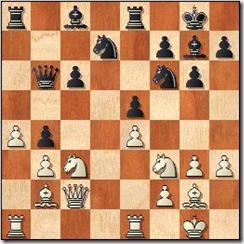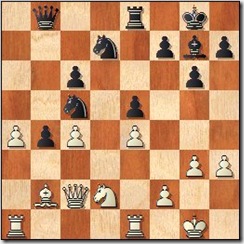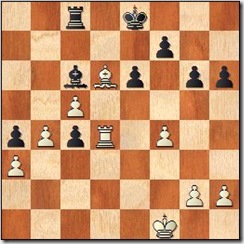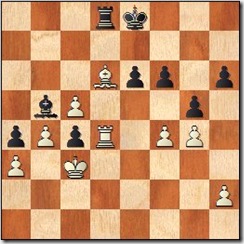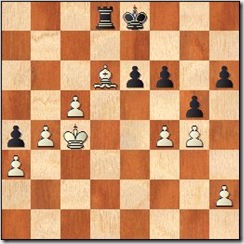Jiganchine,Roman (2246) - Lipnowski Michael (1799) [E69] Canadian Junior (7), 05.01.2002, Winnipeg
We often read in chess books about "positional exchange sacrifices", and if a grandmaster gives up his rook on c3 for a knight in Sicilian, we make wise "knowing smiles" and don't think of this as anything special. However, as I must admit, in the following game my opponent's positional sacrifice came as a total shock for me. Even if there was a refutation, I could not think normally, and decided to escape with a draw offer. 1.d4 Nf6 2.c4 g6 3.Nc3 Bg7 4.Nf3 0-0 5.g3 d6 6.Bg2 Nbd7 7.0-0 e5 8.e4 Re8 [8...c6 is the most popular choice.] 9.Re1 c6 10.h3 Qc7 11.b3 [11.Be3 exd4 12.Nxd4 Nc5 13.Qc2 a5 14.Rad1 Bd7 15.b3 Rad8 16.f4 Bc8 17.Bf2 and white scores really well from here 17...Re7 18.Nde2 Nfd7 19.Qd2 Re6 20.e5 Bf8 21.Nd4 Ree8 22.exd6 Rxe1+ 23.Qxe1 Qb8] 11...a6 [11...exd4 12.Nxd4 Nc5 is another option] 12.Bb2 b5 13.cxb5 axb5 14.Qc2 Qb6 15.dxe5 dxe5 16.a4 b4 Diagram
A positionally dangerous move, as now White has a protected a4 pawn, c4 outpost and pressure along 'c' file. Michael, however, had a creative idea in mind... ? ! [16...bxa4 17.Nxa4+/=] 17.Nb1 Ra5 18.Nbd2 Rc5 19.Nc4 Ba6 20.Bf1 Qb8 21.Qd2? the strange rook on c5 played its role: I fail to find the right way: [21.Bc1! Bxc4 (21...Nb6 22.Be3 Rxc4 23.bxc4) 22.Bxc4 Ra5 23.Be3 would bring White a solid positional advantage.] 21...Bxc4 22.Bxc4 [22.bxc4 Ra5 is fine for Black] Diagram
22...Rxc4 Objectively, I believe the sacrifice was not fully correct: for the exchange Black gets a great square for his knight on c5, and a dangerous 'b' pawn. Everything depends on whether or not Black will manage to activate the rest of his pieces and prevents me from pushing the 'a' pawn. !? 23.bxc4 Nc5 24.Qc2 Nfd7 [Being a materialist by nature, I expected 24...b3 !? If White plays incorrectly, Black gains powerful initiative. For example: 25.Qd2 ?! (25.Qb1+/= ! is best; now because the weak e5 pawn Black has problems) 25...Nfxe4 26.Qa5 Nxf2 27.Qxc5 Nd3 28.Qa3 e4] 25.Nd2 [2010: 25.a5!? passed pawns must be pushed] Diagram
25...h5 !? Black's last several moves had a strong psychological effect on me: instead of trying to get material back, he plays moves that pursue purely positional long term goals: for example, weakening my king. 26.Nb3 ? rather pointless, because the exchange of knights favours Black. Better was [26.a5 and if 26...Na6 27.Nb3] 26...h4 27.Nxc5 [27.a5] 27...Nxc5 28.Bc1 ? [after 28.gxh4 ! ? 28...Qd8 Black wins the pawn back and gets his queen activated. Besides, I did not want to surrender an important 'f4' square. However, (28...Bh6 29.h5 ! ? 29...gxh5 ? ! 30.Qd1) 29.Qd1 Qxh4 30.Qg4 forces Black to retreat.] 28...hxg3 29.fxg3 Rd8 30.Kg2 1/2-1/2
Being upset about the course of the game (I have to defend!) and now not being able to find ways to consolidate (I missed them!), I offered a draw, which my opponent accepted. The position is already unclear. While the game got no logical conclusion, Black's creative idea was clearly successful! [Here is a possible variation:
30.Kg2 b3 31.Qe2 Rd4 32.Be3 Rxe4 33.Rab1 Bh6 34.Qf3 Bxe3 35.Rxe3 Rxc4 36.Rf1 Rc2+ 37.Kh1 f5 38.Qxc6 Kh7=/+;
30.Rf1 Rd3 31.Qf2 Qf8 and Black has counterplay: 32.Re1 Rc3~~; 30.a5 ? 30...Rd3 31.Be3 Rc3]
